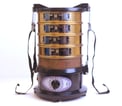Visitors often land on our web pages with the common query, “What exactly does a Sieve Shaker do?”
The straightforward answer is that it's designed to ensure that all particles in a sample come into contact with the openings in each sieve within a stack. A sieve stack is essentially a lineup of sieves stacked on  top of each other, with each sieve having a smaller mesh size than the one above it.
top of each other, with each sieve having a smaller mesh size than the one above it.
A sieve stack can range from 1 to 18 sieves, depending on industry standards or specific product requirements. The ideal motion of a sieve shaker is circular and vertical, also known as orbital motion. Early mechanical shakers, like the Ro/Tap© by W.S Tyler, used rotating orbital tables and hammers to achieve this motion, although they were quite noisy.
Various developments were made to reduce the noise and improve the efficiency of sieve shakers, such as:
- cam-driven sieve plates,
- offset weights,
- horizontal leaf springs, and
- magnets.
 Understanding the function of sieve shakers and selecting the right model is crucial for accurate particle separation in different materials. Techniques like wet sieving, ultrasonic agitation, or vacuum-assisted separation may be necessary for specific materials or particle sizes.
Understanding the function of sieve shakers and selecting the right model is crucial for accurate particle separation in different materials. Techniques like wet sieving, ultrasonic agitation, or vacuum-assisted separation may be necessary for specific materials or particle sizes.
In essence, the purpose of a sieve shaker is to facilitate the efficient separation of particles smaller than the sieve openings. The choice of the appropriate sieve shaker model depends on the characteristics and size of the sample being analyzed.
I hope this sheds some light on the function of sieve shakers and the considerations involved in selecting the right one.
Regards,
Cho
Thanks for visiting!
P.S. If you are not subscribed to these Test Equipment rants and muses, sign up at the top of the page.
See Shaker Sam Show A Meinzer II Quiet Sieve Shaker
See Meinzer II Specs and request a quote


